Sally Clark’s Conviction of Murdering Two of Her Children is Quashed After Discovery the Prosecution Concealed Evidence of Her Innocence
By Hans Sherrer
For Justice Denied Magazine
(Feb. 19, 2003)
Introduction:
Sally Clark was released on January 29, 2003 after more than three years of wrongful imprisonment. Earlier that day her November 1999 conviction of murdering two infant sons 13 months apart was quashed as “unsafe” by the U.K.’s Court of Appeals. It was discovered more than a year after her trial that her prosecutors had concealed medical evidence supporting her innocence. A successful lawyer whose prominent position didn’t prevent unscrupulous prosecutors from destroying her life, Sally Clark symbolizes the plight of women in countries around the world who have been wrongly convicted and imprisoned as the murderer of one or more children whose death was from natural causes.
In December 1996, Sally and Stephen Clark were both successful corporate lawyers who lived with their 11-week old son Christopher Clark, in Wilmslow, Chesire, near Manchester, England.
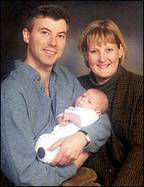
Sally, Stephen and baby Christopher
Looking in on Christopher on the fateful night of December 13th, Sally noticed he was a “dusty, grey colour,” and he appeared to have stopped breathing. [1] Stephen wasn’t home, and the paramedics she called arrived within minutes. However, they were unable to revive him. Christopher’s sudden death was attributed by a pathologist to a lower respiratory tract infection. [2]
The couple’s second child, Harry, was born on November 29, 1997. Just eight weeks later, on January 26, 1998, Harry Clark died as suddenly as his brother Christopher had. While Stephen was preparing a feeding for Harry, Sally noticed he had slumped forward in his chair. [3] Neither Stephen nor paramedics were able to revive Harry.
Both children died in the family’s home. A pathologists report shown to the parents concluded Harry died from a “non-accidental injury consistent with shaking.” [4] Sally and her husband protested that conclusion was baseless. However, relying on that report and the suspiciousness of the deaths occurring 13 months apart, prosecutors recast Christopher’s death as not accidental.
In July 1998, while pregnant with her third child, 34-year old Sally Clark was charged with the murder of her sons Harry and Christopher.
In October 1999 she went on trial in the Cheshire Crown Court, accused of smothering Christopher and shaking Harry to death. Knowing it needed to make Sally appear as an unsympathetic character, the prosecution worked overtime to smear her by publicly portraying her as a depressed “lonely drunk” who was pushed over the edge by the demands of taking care of young babies. [5] Defending against a circumstantial case unsupported by any physical evidence or witnesses to her abusing Harry or Christopher, Sally asserted her innocence prior to and throughout her trial. Testifying on her own behalf she said: “It was just complete disbelief that it could happen a second time. I was meant to have children. I loved them so much. I couldn’t believe it.” [6]
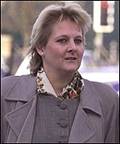
Sally Clark at the time of her trial.
In England a unanimous verdict is not required for a person to be convicted of murder, and on November 9th, after deliberating for two days, the jury voted by a 10-2 majority for her conviction. [7] Newspaper headlines all over the U.K. screamed that Sally Clark was a BABY KILLER! [8] However, the headlines, news stories, editorials and law enforcement officials condemning her as a monster totally ignored a tell-tale sign that something wasn’t right about her conviction: Although the prosecution threw everything it could muster against Sally Clark during her 18-day trial, 17% of the jurors were unconvinced she was guilty. [9]
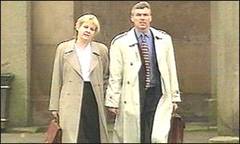
Sally and Stephen Clark walking out of the courthouse during her 1999 trial.
She was sentenced to two concurrent terms of life in prison and appealed her convictions.
In spite of setback after setback, Stephen Clark resolutely stood beside his wife as the deaths of their sons were investigated, and as she was charged, convicted, sentenced and imprisoned. Immediately after his wife’s conviction he said, “During both their short lives my wife was a caring, devoted mother to our sons. They were not murdered and she is innocent.” [10] He was not alone in his sureness of her innocence. A neighbor who saw Sally with her children expressed the sentiment of many after her trial when she said, “None of us believe she is guilty. She is such a lovely person.” [11] The description of those who knew Sally stood in marked contrast with the prosecution’s characterization of her as an evil blackheart.

The Clark’s home in Wilmslow, Chesire, near Manchester, England.
Facing bankruptcy from the crush of legal fees, Stephen Clark sold the family’s £300,000 (approx. $500,000) home near Manchester. So he could be closer to the prison in Essex where his wife was imprisoned, he moved and took a job as a finance lawyer near London. [12] He visited her with their third son, now four years old, as often as he was allowed. [13]
Considered a fool by many for sticking by a wife convicted of murdering two of their children and facing life in prison, Stephen said, “You could put me down as some stupid, lovelorn idiot but I am a Cambridge graduate and a lawyer who has studied all the papers and taken the best advice from medical and legal experts. .. We have been married over 11 years and have known each other longer. I know Sally better than anyone and she is the kindest, sweetest, most caring person I have ever known” [14]
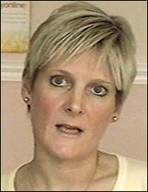
Sally Clark showing the strain of her imprisonment.
In his pursuit to find evidence of his wife’s innocence, Stephen discovered the prosecution’s “expert witness,” Sir Roy Meadow, gave wildly erroneous testimony about the known incidence of “cot deaths” (also known as Sudden Infant Death Syndrome (SIDS)). Sir Meadow testified the odds of two “cot deaths” in one family were 73 million to one, which would mean it happens only once every several years in the United Kingdom. Stephen found evidence that its incidence is actually 8,500 to 1, and every year fifty families in the U.K. suffer the death of a second baby to “cot death,” after having lost a first to the syndrome. [15] Sir Meadow’s false testimony had a devastating effect on the jurors, because it swayed them towards excluding the very real possibility Sally’s two children had died of natural causes. Yet in considering her appeal in 2000, the Court of Appeals casually dismissed as a “sideshow,” arguments about the prejudicial effect his erroneous testimony had on the jurors. [16] That Court upheld Sally’s convictions and sentence on the basis that the case against her was “overwhelming.” [17]
After the appeal went against his wife, Stephen kept digging for the evidence of her innocence that would be so convincing that it couldn’t be ignored.
Oddly, the prosecution had never supplied Sally’s lawyers with all of Harry and Christopher’s medical records from the hospital where they had been taken and tests were performed on them. Stephen had been trying for several years to obtain those records to see if there was something in them that would establish the death of the boys from natural causes. When he told Marilyn Stowe, a divorce lawyer he knew about his frustrations in obtaining the records, she volunteered to try and obtain them. It took several months of negotiations with the hospital, but in late 2000 the hospital supplied the two boy’s complete medical files.
Pouring over the more than a 1,000 pages of hospital files, Stephen hit the mother lode he had been looking for, and which explained the odd difficulty he had in obtaining his children’s medical records. Concealed in one of Christopher’s files, he found a report about Harry that prosecutors had never provided to the defense. [18] For three years the prosecution had maintained that there was “not any evidence of infection or any possible natural explanation” of Harry’s death. [19] The newly discovered report established the prosecution knew that wasn’t true and had deliberately misled Sally Clark’s lawyers. [20] As Marilyn Stowe said of the report, “It gave the cause of death for the second child and it showed the child was ill and was killed by a viral infection and she could not have possibly killed him.” [21] The tests showed that the staphyloccus aureus infection had spread as far as Harry’s cerebral spinal fluid. [22] However, the prosecution failed to disclose that crucial pathology report to Sally Clark’s lawyers, and their government employed pathologist, Dr. Alan Williams, who ordered the blood and tissue tests it was based on did not breath a word about the contents of that report when he testified at her trial. [23]
Yet the baseless charges of murdering Harry would not have been filed against Sally if the prosecution had disclosed the hidden report to her lawyers. That report also undercut the basis of Sally’s conviction of murdering her first child, Christopher, since the original pathologist’s report that he died from the natural cause of a lower respiratory tract infection was only changed after Harry’s death was wrongly attributed to him being shaken to death. [24]
Furthermore, at Sally’s trial Dr. Williams changed his opinion of how Harry had died from being shaken, to being smothered. [25] That supported Sally and Stephen’s claim that she had not physically abused her children. It also laid bare that although the prosecution had relied on Dr. Williams claim that Harry had been abused to file murder charges against her, it was a crass accusation unsubstantiated by any photographs, witnesses or test results. In other words, the prosecution’s pathologist manufactured his claim that Harry was shaken to death out of thin air, and the prosecutor’s then used that fabrication to justify filing murder charges against Sally Clark. A separate and as yet unaddressed issue, is if the deliberately falsified pathologist report attributing Harry’s death to “a non-accidental injury consistent with shaking,” was prepared under the supervision, or at the behest of Sally Clark’s prosecutors. [26] That is a particularly pertinent question given that the prosecutor’s pathologist and witness at her trial, Dr. Alan Williams, knew within days of Harry’s death that it was from natural causes. [27]
Also substantiating the natural deaths of Harry and Christopher was the discovery of a “cot death gene” by researchers at Manchester University (U.K.) in February 2001: “The Interleukin 10 genotype was found to be associated with a threefold increase in the risk of cot death, compared with the normal population.” [28] Dr. David Drucker, one of the microbiologists who assisted in identifying the “cot death gene,” became involved in Sally Clark’s case because he knew that “cot death” was statistically much more common than the testimony at her trial indicated. As he said, “It just isn’t as rare as the jurors were led to believe.” [29]
The discovery of the pathologist’s report concealed by the prosecution, combined with Manchester University’s research was the new evidence needed to open the door for the Criminal Cases Review Commission, which reviews cases of possible miscarriage of justice in the U.K., to order that Sally Clark’s case be reviewed by the Court of Appeals taking the new evidence into consideration. [30]
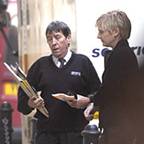
Sally Clark on the first day of her hearing.
On January 28, 2003 the Court of Appeals hearing of Sally’s case began. Sally’s lawyers informed the Court in their pleadings, “It is obvious that, if the results had been made known at trial, Sally Clark would not have been convicted of murdering Harry or his dead brother Christopher.” [31] They also characterized the concealment of the pathologist’s report as a “clear case of non-disclosure by the prosecution.” [32] Although the hearing had been expected to last for four days, the next day the three judges quashed Sally Clark’s conviction and ordered her immediate release based on the evidence presented at the hearing. The crush of publicity about the outrageous circumstances of Sally Clark’s conviction did not allow the judges to gloss over the deficiencies in the prosecutor’s case the way they did in 2000. The Court said, “The jury was deprived of the opportunity of considering medical evidence that may have influenced their decision. … This resulted from the failure of the pathologist to share information that a competent pathologist ought to have appreciated needed to be assessed.” [33]
The plain and simple truth had finally seen the light of day: Sally and Stephen Clark’s two children had died of natural causes, there was never any credible evidence against her, and she was innocent. Yet in spite of her prosecutor’s knowledge of that information prior to filing charges against her, they concealed it through her trial, conviction, sentencing, imprisonment, her first appeal in 2000, and continued to fight to keep her imprisoned after it was disclosed she had been prosecuted for two crimes that never happened - the non-existent murders of her children. The fact Sally Clark was effectively framed by prosecutors for phantom murders emphasizes the magnitude of the Court of Appeals’ error in 2000 when it described the evidence of her guilt as “overwhelming.” During the four and a half years that passed from the filing of charges in July 1998 to the quashing of her conviction by the Court of Appeals, the only people within the system that “had it right” were the two courageous jurors who resisted the pressure exerted on them by the other ten jurors, and voted for her acquittal in November 1999.
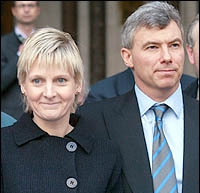
Sally and Stephen Clark leaving the Courthouse after her conviction was quashed and her release ordered by the Court of Appeals.
At 4pm on January 29th Sally Clark was released from custody after 3 years and 3 months of imprisonment. Standing on the steps of London’s central court after her release, Sally Clark made a statement to the press:
“Today is not a victory. We are not victorious. There are no winners here. We have all lost out. We simply feel relief that our nightmare is finally at an end. We are now back in the position we should have been in all along and plead that we may now be allowed some privacy to grieve for our little boys in peace and try to make sense of what has happened to us.
…
Thank you
also to all my friends out here, many of whom have been in court today, who
have shown me unwavering and unconditional support and loyalty. It would have
been understandable perhaps for them to have written to me when all this first
happened, but then to have felt that they had done all they could and that it
was time to move on. But no, they have been at my side throughout. Their
friendship means so much.
The same
goes for my family and, in particular, my Dad. …
Finally, my
husband, Steve, who together with our little boy, is my life. He has stood by
me and supported me throughout this whole nightmare, not through blind love or
unthinking loyalty, but because he knows me better than anyone else and knows
how much I loved our babies. …
May we now
be allowed the privacy to rebuild our lives, to move forward and to learn to be
a proper family again.” [34]
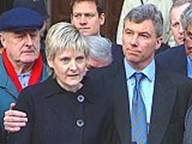
Sally with Stephen’s arm around her, leaving the Courthouse.
After
the quashing of her conviction, the prosecutors said they would not retry Sally
Clark, The Law Society said it would reinstate her as a lawyer in good
standing, and her father, 71 year-old Frank Lockyer said: “I have total
admiration for my daughter and son-in-law with the way they coped with this.” [35]
Two
of the most compelling puzzles about Sally Clark’s case are why the government’s
prosecutors methodically sought to obtain her murder convictions when they had
reason to believe with a scientific certainty that she was innocent, and why they
then fought to fight to keep her imprisoned when their duplicity had been
publicly disclosed. Given their conduct, it is improper to dignify Sally Clark’s
ordeal by describing it as a criminal prosecution - since it was one in name
only. Unfortunately the print, radio and television media’s thirst for
sensational stories made them into willing dupes in the charade of Sally
Clark’s prosecution. It is all too easy for prosecutors to misuse the criminal
process to cover-up a person’s innocence so he or she can be branded a criminal
and imprisoned under the illusion that they have committed a crime when they in
fact have not. The world now knows that is what happened to Sally Clark.
THE
END
Author’s Notes:
1)
Although Sally Clark’s was framed by prosecutors in the United Kingdom, the
same circumstances leading to her wrongful conviction can, and very likely are
happening to women in the U.S. and other countries. An article published in the
Guardian newspaper (U.K.) at the time of Sally Clark’s release reported there
are a number of other women languishing in British prisons that have been
convicted of killing one or more children that very possibly could have died of
natural causes. [36]
2)
Sally Clark’s case reaffirms an important truth as applicable to this country
as the U.K. The evidence resulting in an innocent person’s exoneration is typically
unearthed by family members, friends, or concerned strangers, and only rarely
by the person’s attorney. That is because the crucial missing evidence needs to
be discovered precisely because it is not in the record of the case or in the
information provided by the prosecution. It was Stephen Clark’s relentless
search for evidence that could aid his wife that led to discovery of the key
medical report concealed by the prosecution. Without that, her lawyer’s could
have done nothing to exonerate her, and she would have spent decades trapped in
Britain’s hellish prison system before she would have been eligible for parole
as an old woman.
3)
Sally Clark’s case also reaffirms that it is as true in the U.K. as this
country that nothing a prosecutor ever says can ever be
taken on faith or at face value. All meaningless platitudes aside, prosecutors
in the U.K. and this country are driven by the end of obtaining a conviction by any means necessary – and the truth be damned. [37] The failure of the Appeals Court in 2000
to intensely scrutinize the prosecution’s case against Sally Clark contributed
to their affirmation of her conviction as based on “overwhelming” evidence of
her guilt – when there was in fact no substantive evidence supporting the prosecutor’s
claim she murdered her children. The prosecution’s case against Sally Clark was
based on nothing more than hot air. In an all too typical display of
megalomania, Sally Clark’s prosecutors continued bellowing hot air by denying
any wrongdoing by their concealment of the crucial medical records that Marilyn
Stowe and Stephen Clark discovered on their own.
4)
The author read about Sally Clark’s case in the Spring of 2002, while compiling
cases of wrongful conviction from around the world to add to his wrongful
convictions database. It was apparent she had been horrifically victimized by
prosecutors gone mad who literally had no concern whatsoever that there was no
evidence of her guilt. It was also apparent the prosecutor’s depended on erroneous
and deceptive testimony by their so-called “expert witnesses” to obtain her
conviction. Consequently the author wrote Sally Clark and her father, Frank
Lockyer suggesting that she be interviewed live on a U.S. radio station from
her prison in the U.K. Mr. Lockyer responded to that inquiry by indicating he
thought the logistics of trying to arrange the interview, given the significant
time difference and the circumstances of her imprisonment, made it unfeasible.
He also expressed hope about the outcome of her then upcoming review of her
conviction by the Court of Appeal. Fortunately for his daughter, they looked at
the prosecutor’s case with a criticality that they didn’t in 2000, and that is
why she was freed on January 29, 2003. The author’s wrongful conviction
database is at: www.forejustice.org/db/innocents.htm, and it includes an entry
for Sally Clark.
Endnotes: